补充语法知识老师给的哦
七年级语文语法知识补充

叹词
表示感叹或呼应的词,如“啊 、哼、咦”等。
02 短语类型
并列短语
并列短语是由两个或两个以上的词语 并排组合而成,这些词语在语法上地 位相等,无主次之分。例如:“我和 你”、“城市和乡村”。
并列短语的词语间常有反义、同义、 类义等关系,可以根据语义关系进行 分类。
主谓短语
01
主谓短语是由主语和谓词组成的 短语,主语是陈述的对象,谓词 是陈述的内容。例如:“我喜欢 音乐”、“他走了”。
ห้องสมุดไป่ตู้
状语由介词短语、副词、从句等充当,修饰动词、形容词、副词等。
状语在句子中通常不可省略,否则会影响句子的完整性和意义。
定语
定语是用来修饰名词的词语,表示名 词的属性或特征。
定语在句子中通常不可省略,否则会 影响句子的完整性和意义。
定语由形容词、数词、从句等充当, 修饰名词。
04 常见病句类型及修改
要点二
详细描述
表意不明通常表现为多义词的使用、指代不明、省略不当 等。例如,“他拿着一本书和一支笔,走进了图书馆。” 这个句子中的“和”字使用不当,容易引发歧义,应该改 为“拿着”或“拿着两样东西”。
THANKS FOR WATCHING
感谢您的观看
详细描述
语序不当通常表现为定语、状语、补语的错位,或者句子成分的颠倒。例如,“我非常喜欢读小说, 特别是那些著名的作家写的。”这个句子的语序不当,正确的顺序应该是“我非常喜欢读那些著名的 作家写的小说。”
搭配不当
总结词
搭配不当是指句子中词语的搭配不恰当 ,导致句子不合逻辑或语义矛盾。
VS
详细描述
搭配不当通常表现为主谓搭配不当、动宾 搭配不当、修饰语与中心词搭配不当等。 例如,“他的态度非常诚恳,我很不高兴 。”这个句子的主谓搭配不当,“态度” 和“诚恳”不搭配。
初中语法知识总汇(补课用)

语法知识(一)一.语素语素是语音语义的最小结合体,例如:人、吃、大、十等。
语素构成词。
语素可以单独成词,也可以与别的语素组合成词,例如:“人”;“人参”。
“吃”;“吃亏”。
二.词类词可分实词和虚词两大类。
实词表示实在意义,能够作短语或句子的成分,一般能够独立成句。
实词包括名词、动词、形容词、数词、量词、代词。
虚词一般不表示实在的意义,它们的基本用途是表示语法关系。
虚词包括副词、介词、连词、助词、叹词和拟声词。
(1)名词表示人或事物名称的词。
例如:学生,友谊,早晨,前面等。
(2)动词表示动作、行为、发展变化、心理活动的词。
例如:走,爱,使,能够,起来,是等。
(3)形容词表示性质或状态的词。
例如:美丽,迅速等。
(4)数词表示数目的词。
例如:百,一些,第一等。
(5)量词表示人、事物的单位或动作、行为的单位的词。
例如:尺,趟等。
(6)代词起代替或指示作用的词。
例如:我,什么,这等。
(7)副词用在动词、形容词前头,表示动作、行为或性质、状态的程度、范围、时间、频率、语气、情貌等。
例如:很,立刻,都,时常,忽然,不,竟等。
(8)介词用在名词(或短语)、代词前头,合起来表示动作行为的起止、方向、处所、时间、对象、目的等。
例如:从,向,在,把,按照,为了,对于,比,除了等。
(9)连词连接词、短语、句子、表示某种逻辑关系。
例如:和,或者,而且,虽然,但是,因为,所以,只有,如果等。
(10)助词附在词或短语、句子后面表示一定的结构关系或附加意义或语气。
例如:的,地,得,着,了,过,吗,啊等。
(11)叹词表示感叹或呼唤应答的词。
例如:喂,哎呀,嗯等。
(12)拟声词摹拟声物声音的词。
例如:砰,轰隆,哗啦啦等。
结构助词“地”“的”可以合用为“的”,即定语、状语都用“的”:(伟大)的人民:(勇敢)的前进。
但不作硬性规定,如分开用,要用得正确,定语用“的”,状语用“地”。
三、短语短语是由词和词构成的,短语可以作为句子成分;大多数短语加上一定的语调就可以成为句子。
七年级下册语文语法知识点
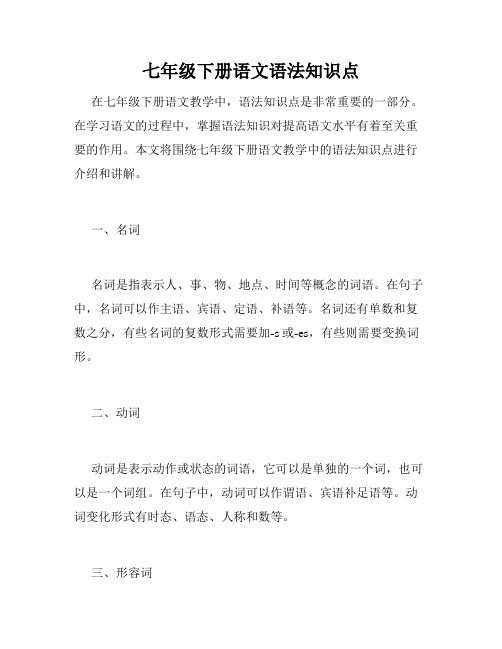
七年级下册语文语法知识点在七年级下册语文教学中,语法知识点是非常重要的一部分。
在学习语文的过程中,掌握语法知识对提高语文水平有着至关重要的作用。
本文将围绕七年级下册语文教学中的语法知识点进行介绍和讲解。
一、名词名词是指表示人、事、物、地点、时间等概念的词语。
在句子中,名词可以作主语、宾语、定语、补语等。
名词还有单数和复数之分,有些名词的复数形式需要加-s或-es,有些则需要变换词形。
二、动词动词是表示动作或状态的词语,它可以是单独的一个词,也可以是一个词组。
在句子中,动词可以作谓语、宾语补足语等。
动词变化形式有时态、语态、人称和数等。
三、形容词形容词是表示人或事物的特征或状态的词语。
在句子中,形容词可以作定语、表语等。
形容词在修饰名词时需要和名词在性、数、格方面一致。
四、副词副词是表示时间、地点、方式等的词语。
在句子中,副词可以修饰动词、形容词、副词等。
有些副词还可以在句子中起连词的作用,如“但是、而且”等。
五、代词代词是用来代替名词或其他代词的词语,如“我、他、它、她、这、那”等。
在句子中,代词可以作主语、宾语等。
六、介词介词是连接词和词语间关系的词语。
在句子中,介词可以引导短语作状语、定语等。
常见的介词有“在、和、从、到、以、与”等。
七、连词连词是连接词语、短语和句子的词语。
在句子中,连词可以连接并列的词语和句子、表示因果关系、转折关系、条件关系等。
常见的连词有“和、或、但、因为、所以、如果”等。
八、语气语气是指表示说话人在句子中表达出的情感和语意的性质。
在汉语中,有陈述语气、疑问语气、祈求语气、祝愿语气、命令语气等。
不同的语气可以通过语调、语气助词等方式来表达。
以上就是七年级下册语文教学中的语法知识点。
学好语法可以提高语文水平,让我们的表达更加准确和流畅。
在语文学习中,我们还要多读、多写、多听,深入理解语文知识和语言规律,提高自己的语文素养。
语文语法基础知识
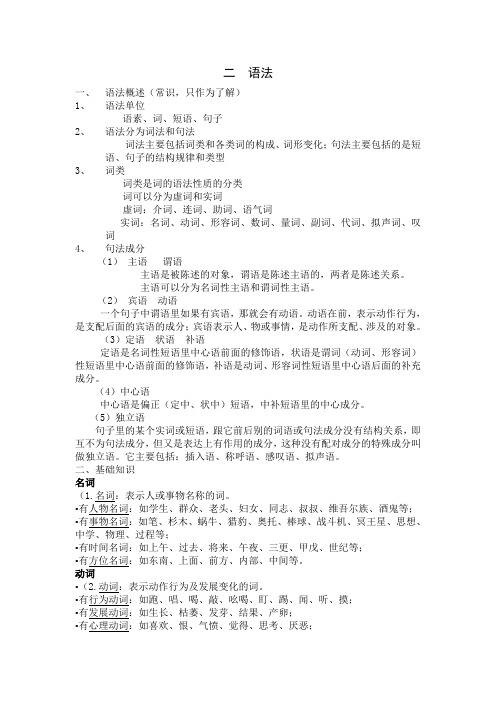
二语法一、语法概述(常识,只作为了解)1、语法单位语素、词、短语、句子2、语法分为词法和句法词法主要包括词类和各类词的构成、词形变化;句法主要包括的是短语、句子的结构规律和类型3、词类词类是词的语法性质的分类词可以分为虚词和实词虚词:介词、连词、助词、语气词实词:名词、动词、形容词、数词、量词、副词、代词、拟声词、叹词4、句法成分(1)主语谓语主语是被陈述的对象,谓语是陈述主语的,两者是陈述关系。
主语可以分为名词性主语和谓词性主语。
(2)宾语动语一个句子中谓语里如果有宾语,那就会有动语。
动语在前,表示动作行为,是支配后面的宾语的成分;宾语表示人、物或事情,是动作所支配、涉及的对象。
(3)定语状语补语定语是名词性短语里中心语前面的修饰语,状语是谓词(动词、形容词)性短语里中心语前面的修饰语,补语是动词、形容词性短语里中心语后面的补充成分。
(4)中心语中心语是偏正(定中、状中)短语,中补短语里的中心成分。
(5)独立语句子里的某个实词或短语,跟它前后别的词语或句法成分没有结构关系,即互不为句法成分,但又是表达上有作用的成分,这种没有配对成分的特殊成分叫做独立语。
它主要包括:插入语、称呼语、感叹语、拟声语。
二、基础知识名词(1.名词:表示人或事物名称的词。
•有人物名词:如学生、群众、老头、妇女、同志、叔叔、维吾尔族、酒鬼等;•有事物名词:如笔、杉木、蜗牛、猎豹、奥托、棒球、战斗机、冥王星、思想、中学、物理、过程等;•有时间名词:如上午、过去、将来、午夜、三更、甲戊、世纪等;•有方位名词:如东南、上面、前方、内部、中间等。
动词•(2.动词:表示动作行为及发展变化的词。
•有行为动词:如跑、唱、喝、敲、吆喝、盯、踢、闻、听、摸;•有发展动词:如生长、枯萎、发芽、结果、产卵;•有心理动词:如喜欢、恨、气愤、觉得、思考、厌恶;•有存现动词:如消失、显现、有、丢失、幻灭;有使令动词:如使、让、令、禁止、勒令;•有能愿动词:如会、愿意、可以、能够、宁可;有趋向动词:如来、去、上、下;•有判断动词:如是、为、乃。
语法知识汇总

语法知识汇总语法是语言的骨架,是一门研究语言结构和规则的学科。
通过掌握语法知识,我们可以准确、清晰地表达自己的思想,避免产生误解和歧义。
在本文中,我将为大家总结一些关于语法的知识点,希望能帮助大家在写作中避免一些常见的语法错误。
首先,我们来看一下句子的基本结构。
一个完整的句子由主语、谓语和宾语构成。
主语通常是句子中执行动作的人或事物,谓语是描述主语动作的词或词组,宾语是动作的承受者或影响者。
例如,“小明吃了一个苹果。
”中,“小明”是主语,“吃了”是谓语,“一个苹果”是宾语。
在句子中,还有一些修饰语可以提供额外的信息。
形容词用于修饰名词,副词用于修饰动词、形容词或其他副词,介词短语用于表达时间、地点、方式等信息。
在使用修饰语时,要注意它们与被修饰词的搭配和位置,以保证句子的通顺和准确性。
此外,连词在句子中也扮演着重要的角色。
连词可以用来连接两个句子、词组或短语,使句子结构更加复杂且丰富。
常见的连词包括“和”、“但是”、“因为”等,它们的使用要符合语境和逻辑。
除了基本句子结构和修饰语、连词的使用,还有一些其他的语法知识需要注意。
例如,时态的正确使用是写作中常见的问题之一。
时态可以用来表示动作发生的时间,包括过去、现在和将来。
在叙述过去的事件时,应使用过去时态;在描述现在的状况时,应使用现在时态;在谈论将来的计划或预测时,应使用将来时态。
掌握正确的时态使用可以使句子更加准确和连贯。
另外,还有一些常见的语法错误需要注意。
例如,主谓一致性是指主语和谓语在人称和数方面的一致。
主语是单数时,谓语动词要用单数形式;主语是复数时,谓语动词要用复数形式。
此外,名词的单复数形式、不定冠词和定冠词的使用也是常见的问题。
正确使用这些语法规则可以提高句子的准确性和流畅性。
综上所述,语法知识对于我们的写作非常重要。
通过掌握句子结构、修饰语、连词、时态等方面的知识,我们可以写出准确、清晰的句子,避免一些常见的语法错误。
不过,在实际写作中,我们还需要结合具体的语境和要表达的内容,灵活运用语法知识,使文章更加生动、有趣。
初中英语语法知识大全

初中英语语法知识大全中学英语语法知识大全英语作为一门国际语言,在全球范围内都具有很高的重要性。
而英语语法作为英语学习的基础,对于初中生来说,学好英语语法知识是非常重要的。
下面将为大家总结初中英语语法知识的大全。
一、词性1. 名词名词是表示人、事物、地点的词语。
名词可以分为可数名词和不可数名词。
2. 代词代词是用来代替名词的词语,分为人称代词、物主代词、指示代词、疑问代词等。
3. 形容词形容词是用来描述名词的特征和性质的词语,一般修饰名词。
4. 副词副词是用来修饰动词、形容词、副词等词语的词语,一般回答“怎样”、“在什么地方”、“到什么程度”等问题。
5. 动词动词是表示行为或状态的词语,分为实义动词和虚拟动词。
6. 数词数词是表示数量的词语,分为基数词和序数词。
7. 介词介词是用来表示方位、时间、原因等关系的词语,常用介词有in、on、at、from等。
8. 连词连词是用来连接词语、词组、句子的词语,分为并列连词、选择连词、结果连词等。
9. 冠词冠词是用于名词前面的词语,包括定冠词和不定冠词。
二、句子结构1. 主谓结构主谓结构由主语和谓语构成,主语通常是名词、代词、动名词或从句,谓语通常是动词。
2. 主谓宾结构主谓宾结构由主语、谓语和宾语构成,宾语通常是名词、代词或动名词。
3. 主谓宾补结构主谓宾补结构由主语、谓语、宾语和宾语补足语构成,宾语通常是名词、代词或动名词,宾语补足语通常是形容词、名词、动词不定式等。
4. 主系表结构主系表结构由主语、系动词和表语构成,表语通常是形容词、名词、副词或介词短语。
5. 主谓状结构主谓状结构由主语、谓语和状语构成,状语通常是副词、介词短语、不定式短语等。
三、时态与语态1. 一般现在时表示经常性、习惯性的动作或事实。
2. 现在进行时表示现在正在进行的动作。
3. 一般过去时表示过去发生的动作或状态。
4. 过去进行时表示过去某个时间正在进行的动作。
5. 一般将来时表示将来要发生的动作或状态。
(完整版)汉语补语语法知识

汉语补语补语是动词或形容词后面的连带成分,补充说明述语的结果、程度、趋向、可能、状态、数量等。
补语与述语之间是补充与被补充、说明与被说明的关系。
构成补语主要由谓语性词语、数量短语和介词短语充当。
①谓语性词语作补语形容词:好低高紧熟快早干净清楚动词:写改听学拿推抹看走听主谓短语:高兴得眼泪都快流出来了气得脸都白了述宾短语:急得想哭说得没有分寸述补短语:痛得昏了过去乱得睡不着联合短语:长得又精干又潇洒累得筋疲力尽状中短语:起得很早窜得比天还高连谓短语:他气得流着眼泪跑了出来羞得转身就跑兼语短语:奇怪得令人无法捉摸忙得使人喘不过气来比况短语:痛得钻心一般急得热锅上的蚂蚁似的②数量短语作补语看了三遍成立五年走了一趟看了两眼住了半个月③介词短语作补语出生在上海钻到衣领里写于20年代初期始于上个世纪语义类型补语可以用来说明动作、行为的结果、状态、趋向、数量、时间、处所、可能性或者说明性状的程度、状态等。
①结果补语结果补语表示述语的结果。
结果补语主要由形容词来充当,也可由少数单音节动词来充当。
结果补语与述语之间不加得”。
例如:写错变好压低抬高抓紧煮熟哭肿踢坏做完洗干净说清楚说完改成听懂学会拿走推倒抹掉打死拉住撞翻叫醒结果补语与述语结合得比较紧密,其间不能加入别的成分。
结果补语后面可以带动词助词了”和过”,也可以带宾语。
例如:抓紧时间压低标准抬高价格哭肿了眼睛踢坏了足球洗干净衣服叫醒他抹掉痕迹推倒了围墙写完了作文拿走了工资学会了上网②趋向补语趋向补语表示事物运动的方向,主要由趋向动词来”、去”、出”、上”、下”、回”、上来”、出来”、回来”、上去”、下去”等充当。
趋向补语和中心语之间不加得”。
例如:走进流进取回跑回送来拿来交上贴上脱下换下走出去跑进来拿出来蹲下来爬起来扔过去缩回去坚持下去由趋向动词来”、去”作补语的格式里,宾语可以放在述补短语之后,也可以放在述补短语之间。
例如送来两本杂志”可以改为送两本杂志来”。
初升高英语衔接之必备基础语法知识
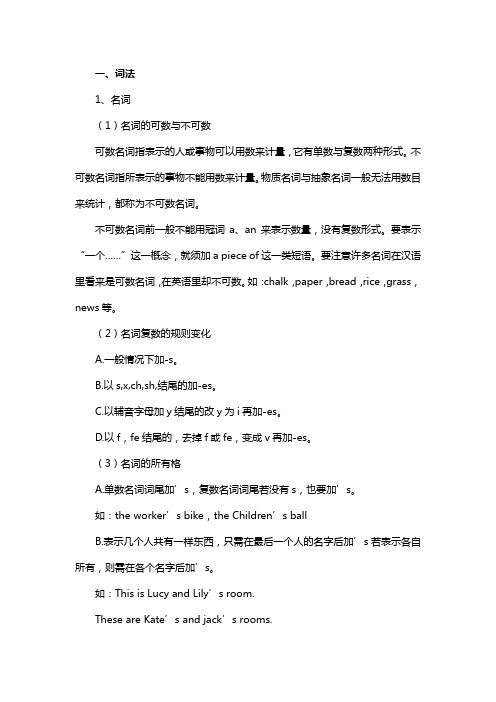
一、词法1、名词(1)名词的可数与不可数可数名词指表示的人或事物可以用数来计量,它有单数与复数两种形式。
不可数名词指所表示的事物不能用数来计量。
物质名词与抽象名词一般无法用数目来统计,都称为不可数名词。
不可数名词前一般不能用冠词a、an来表示数量,没有复数形式。
要表示“一个……”这一概念,就须加a piece of这一类短语。
要注意许多名词在汉语里看来是可数名词,在英语里却不可数。
如:chalk,paper,bread,rice,grass,news等。
(2)名词复数的规则变化A.一般情况下加-s。
B.以s,x,ch,sh,结尾的加-es。
C.以辅音字母加y结尾的改y为i再加-es。
D.以f,fe结尾的,去掉f或fe,变成v再加-es。
(3)名词的所有格A.单数名词词尾加’s,复数名词词尾若没有s,也要加’s。
如:the worker’s bike,the Children’s ballB.表示几个人共有一样东西,只需在最后一个人的名字后加’s若表示各自所有,则需在各个名字后加’s。
如:This is Lucy and Lily’s room.These are Kate’s and jack’s rooms.C.如果是通过在词尾加-s构成的复数形式的名词,只加’。
如:the students’books,the girls’blouses(另外:如果名词是有生命的,我们就用’s结构来表示所有关系。
如果名词所表示的事物是无生命的,我们就要用名词+of+名词的结构来表示所有关系。
)2、代词人称代词,物主代词,反身代词,指示代词,不定代词(1)人称代词第一人称单数I me my mine myself复数we us our ours ourselves第二人称单数you you your yours yourself复数you you your yours yourselves第三人称单数he him his his himselfshe her her hers herselfit it its its itself复数they them their theirs themselves(2)物主代词物主代词的用法:形容词性物主代词后面一定要跟一个名词;名词性物主代词可作主语、表语、宾语。
定语从句专项语法大全

定语从句专项语法⼤全 初中定语从句专项语法⼤全 下⽂是⽼师为们带来的关于对定语从句的概念、定语从句的关系词、定语从句的关系词及关系代词的⽤法等相关的介绍。
⼀、定语从句的概念 在复合句中,修饰某⼀名词或代词的从句叫定语从句。
被修饰的名词或代词叫先⾏词,定语从句⼀般放在先⾏词的后⾯。
⼆、定语从句的关系词 引导定语从句的关系词有关系代词和关系副词,常见的关系代词包括that, which, who(宾格whom,所有格whose)等,关系副词包括where, when, why等。
关系代词和关系副词放在先⾏词及定语从句之间起连接作⽤,同时⼜作定语从句的重要成分。
三、定语从句的分类 根据定语从句与先⾏词的关系,定语从句可分为限制性定语从句及⾮限制性定语从句。
限制性定语从句紧跟先⾏词,主句与从句不⽤逗号分开,从句不可省去,⾮限制性定语从句主句与从句之间有逗号分开,起补充说明作⽤,如省去,意思仍完整。
四、关系代词的⽤法 1. that 既可以⽤于指⼈,也可以⽤于指物。
在从句中作主语或宾语,作主语时不可省略,作宾语可省略。
例如: Mary likes music that is quiet and gentle.玛丽喜欢轻柔的⾳乐。
(that作主语) The coat (that) I put on the desk is blue.我放在桌⼦上的那件外套是蓝⾊的。
(that作宾语) 2.which⽤于指物,在句中作主语或宾语,作主语不可省略,作宾语可省略。
例如: The building which stands near the train station is a supermarket.位于⽕车站附近的那座⼤楼是⼀家超市。
(作主语) The film (which) we saw last night was wonderful. 我们昨天晚上看的那部电影很好看。
(作宾语) 3.who, whom⽤于指⼈,who ⽤作主语,whom⽤作宾语。
苏教版五年级(上)英语语法知识汇总

苏教版五年级(上)英语语法知识汇总一、词类:1、名词: 这里强调两点:不可数名词都默认为单数,所以总是用is名词复数如何加后缀:2、人称代词和物主代词人称代词:有主格和宾格之分。
一般动词前用主格,动词后用宾格。
3、指示代词4、冠词有a、an、the。
a和an的区别:an用于元音音素(一般就是元音字母a、e、i、o、u)前,a用于辅音音素前。
二、否定句:●be动词(am、is、are)+not、●情态动词can+ not、●助动词(do、does)+ not如何将一个肯定的陈述句改为否定句:1、看句中有无be动词,如有,直接在be动词后+ not。
2、看句中有无情态动词,如有,直接在情态动词后+ not。
3、如上述二者都没有,就应用助动词+ not。
分四个步骤:肯定陈述句中本来是没有助动词的,要加上去,位置在主语(某人或某物)后,动词前确定助动词用do、does,根据句中动词,动词是原形的助动词就用do,动词是第三人称单数的助动词就用does,在助动词后加not。
原句中动词假如发生变化就要恢复成原形。
强调一点,有some的要考虑是否要用any。
三、一般疑问句。
如何将一个肯定的陈述句改为一般疑问句:1、看句中有无be动词,如有,把be动词提到句首即可。
2、看句中有无情态动词,如有,把情态动词提到句首即可。
3、如上述二者都没有,就应把助动提到句首。
分四个步骤:肯定陈述句中本来是没有助动词的,要加上去,位置在主语(某人或某物)后,动词前。
确定助动词用do还是does,根据句中动词,动词是原形的助动词就用do,动词是第三人称单数的助动词就用does把助动词后提到句首。
原句中动词假如发生变化就要恢复成原形。
四、特殊疑问句。
表示疑问,有疑问词(在开头),回答有很多种可能。
常用疑问词:五、时态1、一般现在时:●一般现在时中的be动词:一般用原形:am is are①am用于第一人称单数(I);②is用于第三人称单数(he she it和其他人名或称谓,如:Ben his sister等);③are用于第二人称单数(you)和所有复数(包括第一人称复数we、第二人称复数you;第三人称复数they和其他复数,如the children 、his parents等)。
汉语语法知识(四)

汉语语法知识(四)一,复句概说1. 什么是复句复句由两个或两个以上意义相关,结构上互不包含的分句组成.虚心使人进步,骄傲使人落后.片面地只强调读书,而不关心政治;或者片面地只强调政治而不努力读书,都是极端错误的.蓝蓝的天空,巍巍的群山,火红的战旗.2.复句的特点复句的各分句之间一般有停顿,书面上用逗号或分号表示,句末有较大的语音停顿.3.关联词语的运用复句之间有关联词语的叫关联法,不用关联词语表达分句间结构关系的叫意合法.二,复句的类型(一)联合复句1.并列关系:既…也(又) 有时…有时一边…一边是…不是不是…而是2.顺承关系:首先…然后刚…,就3.解说关系:4.选择关系:或者…或者是…还是不是…就是与其…不如宁可…也不5.递进关系:不但…而且不但…反而尚且…何况(二)偏正复句1.转折关系:虽然…但是2.条件关系:只要…就只有…才无论…都3 假设关系:如果…就即使…也4.因果关系:因为…所以既然…就(那么)5.目的关系:以便为的是以免免得省得容易混淆的一组关联词语:不是……就是不是……而是下列句子属于单句还是属于复句由于这项工作,他们受到了奖励.由于完成了这项工作,他们受到了奖励.只有抓紧教育,才能提高全国人民的素质.只有教育,才能提高全国人民的素质.无论是谁,都要遵守纪律.无论你是谁,都要遵守纪律.即使在软席包房里,他还在不断地看资料.即使有了汽油灯,还只能照见小小一块地方.发展体育运动,增强人民体质.我们要坚持发展体育运动,增强人民体质的方针.三,多重复句1,何为多重复句多重复句是指有多个结构层次的复句.其分句间的层次关系都在两层或两层以上.如:一成功的基础是奋斗, 二奋斗的收获是成功, 三所以,天下唯有不知艰难而奋斗的人,才能走上成功的高峰.一般地说,两个分句,可以构成一重复句;三个或三个以上的分句可以构成多重复句.但有三个或三个以上的分句,也不见得就一定构成多重复句.例如:因果并列|‖一他应当以恒心为友, 二以经验为顾问, 三以希望为守护者.一火箭从乳白色的巨大水柱中飞窜而出, 二拖着橘红色的火焰, 三飞向湛蓝的天际, 四然后准确地降落在预定的海域.以上两例都是属于一重复句.||并列并列|||顺承顺承顺承2,分析多重复句的步骤①总观全句,确定分句界限,在每个分句开头标明数码;②找出关联词语,判定分句间的关系;③尽量一分为二,依次用竖线隔开(第一层用单竖线,第二层用双竖线.依此类推 ),并写明关系.逐层分析到单个分句为止.例如:一我赞美白杨树, 二就因为它不但象征了北方的农民, 三尤其象征了今天我们民族解放斗争中所不可缺少的质朴坚强,以及力求上进的精神.因果递进|‖现代汉语语法•句群二,句群的类型句群可以根据不同的标准进行分类.根据层次的多少划分,可以分成一重句群和多重句群两类.根据句际关系划分,句群可以分成并列,顺承,解说,递进,选择,转折,因果,目的,假设,条件,衬附等类.下面先介绍句群的句际关系类型.(一)并列句群常用的关联词语有"也,同时,又"等.可分为平列和对待两小类.例如:①华环由小变大,天气将趋向晴好.华环由大变小,天气可能转为阴雨.②五香瓜子,要吗盐炒葵花子,要吗油炸花生米,要吗③不要变成事实的保管人.要洞悉事实发生的奥秘.(二)顺承句群常用的关联词语有"于是,然后,后来"等.例如:①叶芳压不住火气,突然用拳头发疯似的打着刘思佳的肩膀头.然后,又把脸趴在他的肩上,哭了起来.②听说在很远很远的地方有一座云梯山.山上住着个种树的老爹,白发白眉白胡子.他的胡子很长,从下巴一直拖到地上.(三)解说句群可分为总分式,注解式,特解式,例解式,问答式.例如:①珠宝项链分为长短两种.一种是紧贴脖颈的短项链,另一种是垂挂式的长项链.(总分式)②电流和抵抗成反比例嘛.就是说,抵抗越大,电流越小;抵抗越小,电流越大.(注解式)③他把我那件破得可怜的衬衫洗干净了,并且缝好了.这件衬衫是我第一次受审时的牺牲品.(特解式)④还有,以为诗人或文学家高于一切人,他的工作比一切工作都高贵,也是不正确的观念.举例说.从前海涅以为诗人最高贵,而上帝最公平,诗人在死后,便到上帝那里去,围着上帝坐着,上帝请他吃糖果.(例解式)⑤我们这么大一个国家,怎么才能团结起来,组织起来呢一靠理想,二靠纪律.(问答式)现代汉语语法•句群(四)递进句群常用的关联词语有"而,并且,甚至,何况"等.例如:①有人说幸福是抽象的,那是因为他没有得到真正的幸福.而且,他所谓的幸福是对人人而言.②仿佛从这一天起,未庄的女人们忽然都怕了羞,伊们一见阿Q走来,便个个躲进门里去.甚而至于将近五十岁的邹七嫂,也跟着别人乱钻,而且将十一岁的女儿都叫进去了.③便是七斤嫂,那时不也说,没有辫子倒也没有什么丑么况且衙门里的大老爷也还没有告示.(五)选择句群常用的关联词语有"或者,还是"等.例如:①我又模糊地睡去了吗或者我在嘻嘻地笑你的愚蠢吗或者我在怜悯你的困苦吗②还是历来惯了,不以为非呢还是丧了良心,明知故犯呢(六)转折句群常用的关联词语有"但是(但),可是,然而,不过"等.例如:①他有点傻气,有点呆气,姜亚芳就说他是书呆子.可是,这个书呆子会念诗,而且念得那么好!②焦大的骂,并非要打倒贾府,倒是经贾府好,不过说主奴如此,贾府就要弄不下去了.然而,得到的报酬是马粪.(七)因果句群常用的关联词语有"所以,因此"等.例如:①湿沙层的水分足够供应固定沙丘的植物的需要.所以在流动沙丘上植林种草,是可以成活的.②作品的句子有长有短,短句子可以一口气读完,而长句子有时候则需要分成几段来读.因此,停顿是有声语言表情达意必不可少的手段.前果后因的句群常在后面句子中用"因为".例如:③有许多人,下车伊始,就哇喇哇喇地发议论,提意见,这也批评,那也指责,其实这种人十个有十个要失败.因为这种议论和批评没有经过周密调查,不过是无知妄说.现代汉语语法•句群(八)目的句群表示目的的句子可以是积极的目的,也可以是消极的目的.常用的关联词语有"为的是,省得"等.例加:①我勤奋学习,刻苦锻炼.为的是夺回那失去了的宝贵时间.②你来了好!省得我去找你.(九)假设句群常用的关联词语有"那么,那"等,前面的句子一般是问句.例如:①你对于那个问题不能解决吗那么,你就调查那个问题的现状和它的历史吧!②倘使后来对此用了"侵略"一词呢那就会变成"干了坏事,不尊重他们"了.(十)条件句群这种类型比较少见.例如:①你爱喝的咖啡多得很!我还有一瓶哩!只要你能喝.三,多重句群具有两个或两个以上层次的句群叫多重句群,又叫复杂句群.只有一个层次的叫一重句群或简单句群.例如:并列①(一)母亲站起来去找她两个女儿.|二]我也端详解说了一下那个人.‖[三]他又老又脏,满脸皱纹,眼光始终不离开他手里干的活儿.②[一]在煤业联合公司大厦的总入口处,军队的解说并列夜间活动继续着.‖[二]车和摩托车不断开来.‖‖递进[三]官兵们不断进进出出,步枪和马刺锵锵作响.|‖转折[四]还听到外国人的刺耳的谈话声.|[五]但是煤业公司的窗上都遮着黑纸.四,句群和复句,段落(一)句群和复句句群和复句既有联系,也有区别.句群和复句的联系主要表现在,句群的句子之间的关系类型和复句的分句间的关系类型基本上是相同的.因而在一定语境中有些句群可以变换成复句,有些复句可以变换成句群.例如上面句群例①,在不强调"历史是过去的事实"的重要性和独立性的时候.后面隔离性停顿可以改用句内连续性停顿,书面上把句号改为逗号,这样,句群就变成复句了.同理,例②在一定条件下也可以改成复句.反过来,一个复句,特别是复杂的多重复句,也是可以变换成句群的.不过,变不变,采用句群的形式,还是采用复句的形式,都要根据语境和表达的需要而定.四,句群和复句,段落句群和复句的根本区别是构成单位不同:句群的构成单位是句子,复句的构成单位是分句.其次,二者关联词语的使用情况不同:在复句中经常成对运用的关联词语,有些在句群中不能出现.如"又……又""也……也""尚且……何况""不是……就是""与其……不如""宁可……也不""之所以……是因为""既然……那么""即使……也""只有……才""无论……都"等.这是因为它们互相呼应,联系紧密,不容易分开成为几个句子.另外,有些句式如问答句式,连问句式,连叹句式等,在句群中有,在复句中却没有.这是因为复句只是一个句子,内部的分句不能用句子充当.因此,句群和复句有些是不能互相变换的.例如,上面句群例③是问答句式,例④后句中间用了分号,内部给构复杂,这两例都不能变换成复句.上一节"联合复句"中"并列关系"的例②例⑥,"选择关系"的例22至27等,不改动关联词语都不能变换成句群,这是因为句群不可能运用其中的成对的关联词语.四,句群和复句,段落(二)句群和段落这里的段落指的是自然段.一个自然段如果是由一个句子构成的,则段落中没有句群,如果是由几个甚至几十个句子组成的,则可能分出一个或几个句群;或分析为既有句群,也有句群之外的句子.由此可见句群和段落是两个不同的概念.其区别主要有两点1)句群是语言使用单位,属语言学范畴;划分的依据主要是语意上的向心性,逻辑上的条理性和相应的关联词语.自然段是文章结构单位,属文章学范畴;它的划分要受到多种因素的制约,如文章的内容,风格,体裁,流派,作者的个性,习惯等等.二者相比,自然段具有更大的任意性.(2)划分的目的不同.划分句群主要是为了研究句群的结构规律及其表达效果;划分自然段主要是为了使文章的眉目清楚,结构显豁.五,句群运用中常见的错误句群在运用中的语病是各种各样的,常见的有以下几种.(一)前后脱节句群里的几个句子在意思上缺乏必然的联系,有的句子脱离中心意思.例如:①[一]我们每一个人都应该去植树,不能去毁树.〔二〕植树和毁树是一对矛盾.[三]要做到这一点是很不容易的.[四]现在社会上还有毁树的现象.[一]句是句群的语意中心,[三][四]句是围绕这个中心说的,[二]跟前后句脱节,应删去.(二)语序不当客观现实之间的联系有一定次序,困此,句群里先说什么后说什么也不是任意的.①[一]人们一般把火山分为活火山,死火山和休眠火山三类.[二]在人类历史以前爆发过,迄令为止没有爆发过的火山叫死火山;在人类历史中爆发过,以后长期处于平静, 但仍可能爆发的火山叫休眠火山;经常的成周期性喷火的火山叫活火山.这个句群,包含两句.前一句是总说,提到三种火山;后一句有三个分句,分说三种火山,但没有按总说中的"活火山,死火山,休眠火山"的次序说,显得条理不清,连贯性差.(三)前后矛盾①[一]在一次战斗中,连长腰部负了重伤,因流血过多昏过去了.[二]战士们送他回后方,他用坚定的口气说:"不要管我!追击敌入要紧!"连长既然"昏过去了",就不能说出神志清醒的话.如果说"不要管我!追击敌人要紧!"是连长清醒之后说的,那也应该交代清楚.(四)答非所问这种语病出现在自问自答或甲问乙答的解说句群中.①(一)"志"是怎么得来的呢[二]是天生的吗[三]不.[四]古人云:"世上无难事,只怕有心人."[五]"有心人"即教导人们要有恒心,要善于做长期艰巨的工作.[六]古时李时珍花了一生的精力,攀山涉水,走遍天涯海角,才写出一部伟大的科学著作——《本草纲目》.本例共六句.问的是"'志'是怎么得来的",下文并未对此作正面回答,转而大谈要做"有心人".答非所问,语意不连贯.(五)重复多余①〔一〕昨晚上我们全家去山东剧院看电影. 〔二〕六点半出发.〔三〕去早了也没有意恩.〔四〕剧院门前人山人海.〔五〕我们在大门口检票后就进场了.〔六〕没有票的不能入场.例①中〔三〕 ,〔六〕两句是废话,应删去.。
部编版六年级下册英语语法知识专项复习
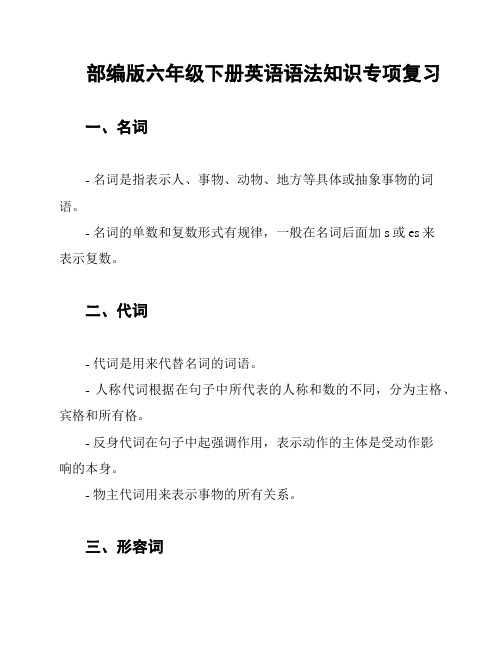
部编版六年级下册英语语法知识专项复习一、名词- 名词是指表示人、事物、动物、地方等具体或抽象事物的词语。
- 名词的单数和复数形式有规律,一般在名词后面加s或es来表示复数。
二、代词- 代词是用来代替名词的词语。
- 人称代词根据在句子中所代表的人称和数的不同,分为主格、宾格和所有格。
- 反身代词在句子中起强调作用,表示动作的主体是受动作影响的本身。
- 物主代词用来表示事物的所有关系。
三、形容词- 形容词是修饰名词或代词的词语,用来描述事物的性质、特征等。
- 形容词有原级、比较级和最高级三种形式,用来表示事物的程度、大小等关系。
四、动词- 动词是表示人、事物或动作状态的词语。
- 动词的时态包括一般现在时、一般过去时和进行时等。
- 动词的形式变化包括三单形式、现在分词和过去分词等。
五、副词- 副词是修饰动词、形容词、副词等词语的词语,用来表示时间、地点、程度、方式等。
- 副词有规则和非规则形式,一般在形容词后面加-ly构成。
- 副词有比较级和最高级两种形式,用来表示事物的程度、大小等关系。
六、介词- 介词是连接名词或代词与其他词语的词语。
- 介词一般位于名词或代词之前,表示时间、地点、方向、目的等关系。
七、连词- 连词是连接词与词、词与短语、短语与短语以及句子与句子的词语。
- 连词有并列连词、选择连词和逻辑连词等多种类型。
八、冠词- 冠词是用来限定名词的词语,分为定冠词和不定冠词。
- 定冠词the用来表示特指的人或事物,不定冠词a/an用来表示泛指的人或事物。
九、数词- 数词是用来表示数量的词语,包括基数词和序数词。
- 基数词用来表示数量的多少,如one, two, three等。
- 序数词用来表示次序的排列,如first, second, third等。
以上是部编版六年级下册英语语法知识专项复习的内容,希望对你的学习有所帮助。
小学语文语法知识点

小学语文语法知识点一、名词名词是指表示人、事物、动物、地点等具体、抽象事物的名称。
名词基本用法包括单数形式、复数形式、可数名词、不可数名词等。
1. 单数形式:指一个人、事物或概念的名称,如“桌子”、“学生”。
2. 复数形式:表示多个人、事物或概念的名称,一般在名词后面加上“们”、“些”等,如“桌子们”、“学生们”。
3. 可数名词:可以用数量单位进行计数的名词,如“学生”、“书”。
4. 不可数名词:无法用数量单位进行计数的名词,如“水”、“欢乐”。
二、形容词形容词是指用来描述或修饰名词和代词的词语,形容词的基本用法包括形容词作前置定语、形容词作表语、形容词的比较级和最高级等。
1. 形容词作前置定语:形容词一般在名词前面修饰名词,如“美丽的花朵”。
2. 形容词作表语:形容词可以直接与系动词连用作表语,如“天空晴朗”。
3. 形容词的比较级:用来表示两个人或事物之间的比较,一般在形容词前面加上“更”或“比较”,如“更高的山”、“比较聪明的孩子”。
4. 形容词的最高级:用来表示三个或三个以上的人或事物之间的比较,一般在形容词前面加上“最”,如“最美丽的风景”。
三、动词动词是表示人或事物的行为、状态的词语,动词的基本用法包括动词的时态、语态、各种类型的句子中的动词搭配等。
1. 动词的时态:用来表示动作或状态的发生时间,常用的时态有一般现在时、一般过去时、一般将来时等,如“我学习中文。
”2. 动词的语态:表示动作的主语是执行者还是承受者,常用的语态有主动语态和被动语态,如“猫吃鱼”(主动语态),“鱼被猫吃”(被动语态)。
3. 动词搭配:动词与其他词语搭配使用,形成固定短语或习惯用法,如“开心”、“吃饭”。
四、代词代词是用来代替名词或名词短语的词语,代词的基本用法包括人称代词、指示代词、疑问代词、不定代词等。
1. 人称代词:用来代替人的称呼,包括第一人称、第二人称和第三人称,如“我”、“你”、“他”。
2. 指示代词:用来指示特定的人或事物,包括“这”、“那”、“这些”、“那些”等,如“这本书”。
六年级下册语法知识点
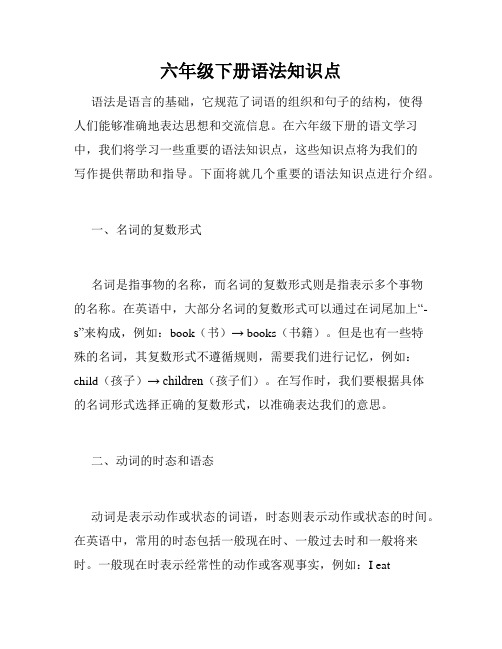
六年级下册语法知识点语法是语言的基础,它规范了词语的组织和句子的结构,使得人们能够准确地表达思想和交流信息。
在六年级下册的语文学习中,我们将学习一些重要的语法知识点,这些知识点将为我们的写作提供帮助和指导。
下面将就几个重要的语法知识点进行介绍。
一、名词的复数形式名词是指事物的名称,而名词的复数形式则是指表示多个事物的名称。
在英语中,大部分名词的复数形式可以通过在词尾加上“-s”来构成,例如:book(书)→ books(书籍)。
但是也有一些特殊的名词,其复数形式不遵循规则,需要我们进行记忆,例如:child(孩子)→ children(孩子们)。
在写作时,我们要根据具体的名词形式选择正确的复数形式,以准确表达我们的意思。
二、动词的时态和语态动词是表示动作或状态的词语,时态则表示动作或状态的时间。
在英语中,常用的时态包括一般现在时、一般过去时和一般将来时。
一般现在时表示经常性的动作或客观事实,例如:I eatbreakfast every day(我每天吃早餐)。
一般过去时表示过去发生的动作或状态,例如:She played soccer yesterday(她昨天踢足球)。
一般将来时表示将来要发生的动作或状态,例如:We will have a party tomorrow(我们明天要举办聚会)。
另外,动词的语态表示动作发出的主体和承受的对象。
常见的语态包括主动语态和被动语态。
在主动语态中,动作的执行者是主语,而在被动语态中,动作的承受者是主语。
例如:Tom broke the window(汤姆打破了窗户)是主动语态,而The window was broken by Tom(窗户被汤姆打破了)是被动语态。
在写作时,我们要根据需要选择正确的时态和语态,以清晰地表达我们的意思。
三、形容词和副词的比较级和最高级形容词用于修饰名词,描述事物的特征。
而副词则用于修饰动词、形容词或其他副词,表示程度、方式等。
高中语文语法知识补充讲解

语法知识补充一、汉语词性分类(一)实词:名词、动词、形容词、数量词、代词.重点:代词代词是有代替、指示作用的词。
代替人或事物名称的叫人称代词;表示疑问的叫疑问代饲。
指称或区别人、物、情况的叫指示代词。
人称代词可分三种: 第一人称指说话一方,单数用“我”,复数用“我们”或“咱们”。
第一人称指听话的-方,单数用“你”,敬称用“您”;复数用“你们”,敬称用“您几位”、“您诸位”。
三人称指说话和听话以外的第三方,一单数用“他、她、它”,复数加“们”,“它”不指人而指物。
“我们”和“咱们”的用法并不完全一样。
“咱们”一定包括说话人和听话人的双方,可以称为“包括式”,“我们”和“咱们”在同一场合出现,“我们”只包括说话人在内的若干人,排除听话人,可称为“排除式”。
例如几位客人向主人告别时说:“我们走了,咱们再见吧。
”但是,普通话“我们”可以是“排除式”,也可是“包括式”。
例如:人称代词:我、咱、你、您、他、她、它、我们、咱们、你、们、他们、她们、它们、自己、自个、儿、别人、人家、大伙儿、大家、彼此疑问代词:谁、什么、哪、哪儿、哪里、哪会儿、多会儿、几、多少、怎样、怎么、怎么样、多指示代词:这、那、这儿、这里、那儿、那里、这会儿、那会儿、这些、这么些、那些、那么些、这么、这样、这么样、那么、那样、那么样、这么、那么(二)虚词:副词、介词、连词、助词、叹词、拟声词重点:(1)副词副词是限制、修饰动词、形容词表示程度、范围、时间等的词。
表程度的:很、最、极、挺、顶、非常、十分、极其、格外、分外、更、更加、越、越来越、越发、有点儿、稍、稍微、略微、差不多、几乎、过于表范围的:都、总、共、总共、统统、只、仅仅、单、光、一齐、一概、一律表时间频率的:已、已经、曾、曾经、刚、才、刚刚、正、正在、将、将要、就要、马上、立刻、顿时、终于、常、常常、时常、时时、往往、渐渐、一直、一向、向来、从来、总是、始终,永、永远、赶紧表肯定否定的:必、必须、必定、必然、当然、准、的确、不、没有、没、未、别、莫、勿、未必、不必、何必、不便、不用(甭)、不妨表语气的:难道、岂、究竟、到底、偏偏、索性、简直、是、是否、可、也许、难怪、大约、幸而、幸亏、反倒、反正、果然、居然、何尝、其实、明明、恰恰、未免、只好1.副词只有“很”、“极”可以作补语。
语文语法知识补充讲解(老师版)
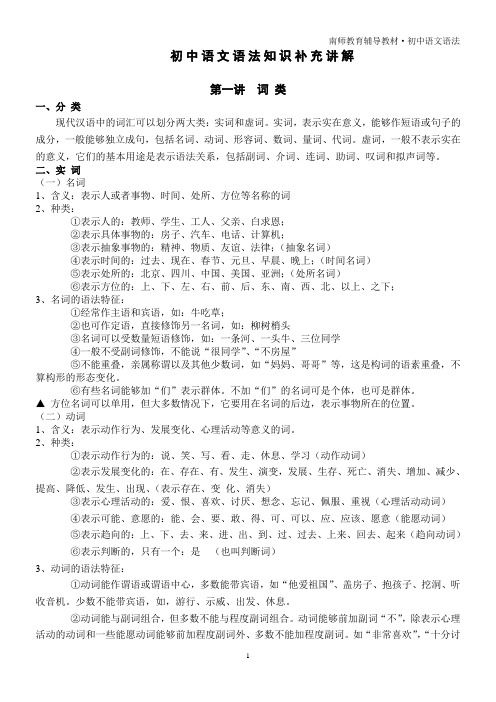
初中语文语法知识补充讲解第一讲词类一、分类现代汉语中的词汇可以划分两大类:实词和虚词。
实词,表示实在意义,能够作短语或句子的成分,一般能够独立成句,包括名词、动词、形容词、数词、量词、代词。
虚词,一般不表示实在的意义,它们的基本用途是表示语法关系,包括副词、介词、连词、助词、叹词和拟声词等。
二、实词(一)名词1、含义:表示人或者事物、时间、处所、方位等名称的词2、种类:①表示人的:教师、学生、工人、父亲、白求恩;②表示具体事物的:房子、汽车、电话、计算机;③表示抽象事物的:精神、物质、友谊、法律;(抽象名词)④表示时间的:过去、现在、春节、元旦、早晨、晚上;(时间名词)⑤表示处所的:北京、四川、中国、美国、亚洲;(处所名词)⑥表示方位的:上、下、左、右、前、后、东、南、西、北、以上、之下;3、名词的语法特征:①经常作主语和宾语,如:牛吃草;②也可作定语,直接修饰另一名词,如:柳树梢头③名词可以受数量短语修饰,如:一条河、一头牛、三位同学④一般不受副词修饰,不能说“很同学”、“不房屋”⑤不能重叠,亲属称谓以及其他少数词,如“妈妈、哥哥”等,这是构词的语素重叠,不算构形的形态变化。
⑥有些名词能够加“们”表示群体。
不加“们”的名词可是个体,也可是群体。
▲方位名词可以单用,但大多数情况下,它要用在名词的后边,表示事物所在的位置。
(二)动词1、含义:表示动作行为、发展变化、心理活动等意义的词。
2、种类:①表示动作行为的:说、笑、写、看、走、休息、学习(动作动词)②表示发展变化的:在、存在、有、发生、演变,发展、生存、死亡、消失、增加、减少、提高、降低、发生、出现、(表示存在、变化、消失)③表示心理活动的:爱、恨、喜欢、讨厌、想念、忘记、佩服、重视(心理活动动词)④表示可能、意愿的:能、会、要、敢、得、可、可以、应、应该、愿意(能愿动词)⑤表示趋向的:上、下、去、来、进、出、到、过、过去、上来、回去、起来(趋向动词)⑥表示判断的,只有一个:是(也叫判断词)3、动词的语法特征:①动词能作谓语或谓语中心,多数能带宾语,如“他爱祖国”、盖房子、抱孩子、挖洞、听收音机。
小学四年级英语语法辅导【三篇】
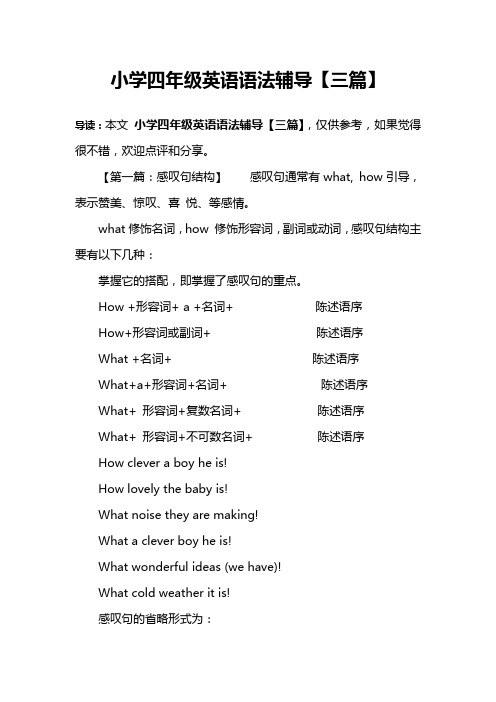
小学四年级英语语法辅导【三篇】导读:本文小学四年级英语语法辅导【三篇】,仅供参考,如果觉得很不错,欢迎点评和分享。
【第一篇:感叹句结构】感叹句通常有what, how引导,表示赞美、惊叹、喜悦、等感情。
what修饰名词,how 修饰形容词,副词或动词,感叹句结构主要有以下几种:掌握它的搭配,即掌握了感叹句的重点。
How +形容词+ a +名词+ 陈述语序How+形容词或副词+ 陈述语序What +名词+ 陈述语序What+a+形容词+名词+ 陈述语序What+ 形容词+复数名词+ 陈述语序What+ 形容词+不可数名词+ 陈述语序How clever a boy he is!How lovely the baby is!What noise they are making!What a clever boy he is!What wonderful ideas (we have)!What cold weather it is!感叹句的省略形式为:What a clever boy (he is)!典型例题1)___ food you've cooked!A. How a niceB. What a niceC. How niceD. What nice答案D. 由于How 修饰形容词,副词;what修饰名词。
且food 为不可数名词,因此A,B 排除。
C How + adj. 后面不能再加名词,因此只有D正确,其句型为What + adj. +n. (不可数)2)___terrible weather we've been having these days!A. WhatB. What aC. HowD. How a答案A. weather为不可数名词,B,D排除。
C为how + adj. 后面不应有名词。
只有A,符合句型What +形容词+不可数名词。
3) --- _____ I had!--- You really suffered a lot.A. What a timeB. What timeC. How a timeD. how time答案A. 感叹句分两类:1:What + n.+主谓部分2:How + adj. / adv. / v.+主谓部分。
七年级语文语法知识补充
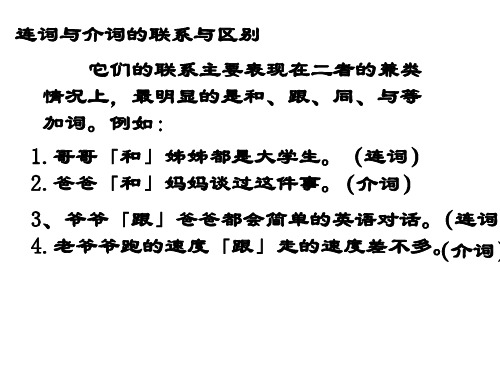
四、叹词的活用
叹词一般不作句子成份,它的基本用法是独立 于句子之外作独立成分或独词句,但有时也可借用它 来作某种句子成份,如作定语、状语、谓语、补语等, 这是叹词的活用现象。例如:
1.她突然「唉」了一声。 (作谓语中心语) 2.我好象听见屋后面有「喂,喂」的叫声。 (作定语) 3.街上有行人「哎哟哎哟」地喊着。(作状语) 4.他气得直「哼哼」。(作补语)
用「的」还是用「地」?
一般规律是:在名词前边用「的」,在动词、形容词前边 用「地」。
「认真de讨论」中的「de」
1.我们认真 地 讨论问题。 2.认真 的讨论使大家对问题认识得更清楚了。
3.大家对这个问题进行了认真 的 讨论。 4.认真 地 讨论问题是十分必要的。 5.经理要求大家认真地 讨论问题。
试一试?
1、 有没有错别字是评定好文章的标准之一。 2、 五十多年来,这位海外游子时刻不在眷 恋自己的祖国。 3、 这样就达到避免产生阻力。
4、 我们必须随时克服并发现自己的缺点。
5、 学校门口有一个专卖汽水和饮料的小摊。
连词与介词的联系与区别
它们的联系主要表现在二者的兼类 情况上,最明显的是和、跟、同、与等 加词。例如:
1.哥哥「和」姊姊都是大学生。( 连词) 2.爸爸「和」妈妈谈过这件事。( 介词)
3、爷爷「跟」爸爸都会简单的英语对话。(连词) 4.老爷爷跑的速度「跟」走的速度差不多(。介 词)
连词前边不能插入其它修饰成份,而 介词则可以。例如:
叹词的语法特点和功能
表示感叹的:啊、唉、嗳、哎等。 表示呼唤的:喂、咳等。 表示应答的:嗯、哦等。
叹词是一种特殊的词类,其语法特点和语法功能是: (一)它不象实词那样,具有词汇意义,
也不作句子成份,也不与其它词组合,发生 结构关系,它总是独立于句子之外,作句子 的独立成分或单独成句。例如: 1. 唉!今天的天气怎么总是下雨。 2.哼!我不理你了。
- 1、下载文档前请自行甄别文档内容的完整性,平台不提供额外的编辑、内容补充、找答案等附加服务。
- 2、"仅部分预览"的文档,不可在线预览部分如存在完整性等问题,可反馈申请退款(可完整预览的文档不适用该条件!)。
- 3、如文档侵犯您的权益,请联系客服反馈,我们会尽快为您处理(人工客服工作时间:9:00-18:30)。
1. 主谓一致主谓语的一致是指谓语动词和主语在人称和数方面须保持一致。
主谓一致的原则有三条:语法一致、概念一致和就近原则。
语法一致指单数的主语接单数的谓语;复数的主语接复数的谓语。
概念一致指谓语动词和主语的一致是根据主语所表示的单、复数概念来决定的,如:The government have broken all their promises./Sixty people means a huge party. 前句中的government是集合名词,指the memebers of the government,在概念上是复数的。
因此动词和人称代词必须用复数形式。
后句中的sixty people从语法标记上看是复数,但表示的概念是单数的:六十个人是一个大群体,因此动词用单数第三人称。
就近原则是指谓语动词的人称和数要与靠近它的那个名词或代词取得一致,如:Tom or his brothers are waiting in the room.关于主谓一致的问题,要特别注意以下几点:•主语从句的数的概念:由whether 和that,who和whoever,what和whatever,which 和whichever,以及when,where,why,how等引导的名词性分句作主语时,谓语动词用单数形式。
但由what 引导的分句作主语时,如果what 分句指的是抽象概念或某一个具体实物,what 分句当单数看待,连接的谓语动词用单数形式。
但如果what 在分句中本身就具有复数的概念(即分句的谓语动词也是复数形式),这时what=those things which,例如:Whoever breaks this law deserves a fine.Whether or not he gets the money doesn’t concern me.When and where this took place is still unknown.How the book will sell largely depends on its author.What I have seen here today has made a very deep impression on me.What I should like most is a dictionary of modern English usage.What are your problems have become mine now.•并列主语的数的概念:当主语后面跟由with,together with,but,along with,like,in addition to,as well as,as much as,rather than,except,more than,no less than 等连接的词组时,其谓语动词的形式依主语的单复数形式而定。
如:John, as well as his brothers, was responsible for the loss.在这里,谓语be 的形式就要依据主语John,而不用考虑as well as 后面加的另外一个名词。
但由or,either…or,neither…nor,not only...but also连接的并列主语,其谓语动词应和最靠近它的那个名词或代词在人称和数方面保持一致。
例如:His parents as well as he are very kind to me.John, James, or Andrew intends to accompany you.Not only the child but also his parents are interested in collecting stamps.•不定式和动名词作主语的数的概念:不定式和动名词作主语时,应接单数谓语动词。
由and 联结的两个不定式或动名词,如果指一个概念,应接单数谓语动词,如果指不同的概念,应接复数谓语动词。
例如:To be one sided means not to look at problems from all sides.Modernizing our country is a profound revolution.To love and to be loved is the greatest happiness.All coming and going was forbidden.To realize the four modernizations and to raise the people’s living standard are our targets for fighting.Hunting and fishing are very good sports.•关系代词的数的概念:关系代词在定语从句中充当主语时,分句的谓语动词必须与关系代词的先行词在人称与数的方面保持一致。
如果关系代词which的先行词不是一个单独的名词(词组),而是一个句子或句子的一部分,这时which所引导的是非限制性定语从句。
分句的动词也只能是单数。
在one of…后面的定语分句中,谓语动词的数应该与of之后的那个复数名词(代词)保持一致,用复数形式。
如果one 之前被定冠词the或the only限定时,分句动词的数应与one 保持一致,用单数形式。
但有时也有one 之前不加冠词而动词既可用单数又可用复数的场合,这时主要根据句子所要表达的意思来选择。
例如:I trust him, who is my best friend.Physics is the science that deals with matter.Our team won the championship, which was something we had not expected.Bob is one of my friends who are helping me paint my house.Bob is the only one of my friends who is helping me paint my house.He is one of those people who knows how to drive a car.在那些人中,他是唯一懂得开汽车的人。
He is one of those people who know how to drive a car. 他是那些懂得开汽车的人之一。
2. 谓语动词的时态、语态和语气2.1 时态时态是英语中谓语动词所表示的动作或情况发生时间的各种形式,常考的时态有一般现在时、一般过去时、一般将来时、现在完成时、过去完成时等八种。
这些时态我们并不陌生,但由于英语时态种类多容易混淆,因此要特别注意以下几点:•时态呼应:在英语复合句中,从句中的动词时态往往受制于主句中的动词时态,通常根据主句时态加以适当调整,这种现象叫时态的呼应。
一般说来,当主句的动词是过去时态,分句的时态不能用现在或将来的时态。
但是在下列情况下,即使主句的动词是过去时态,分句的动词仍可根据句意采用适当时态:(1)宾语分句所指的是一般真理、习惯或特征。
如:Columbus proved that the world is round. (2)宾语分句所指的行为或状态在讲话时刻还在继续着(可能还有继续下去),或者与现在情况有联系。
如:He said just now his son is ill.(3)关系分句和比较状语分句的时态不受主句时态的支配。
如:This is the room in which he was born./He works as hard as I worked.•一般现在时表将来时间或动作:在时间、条件、让步、地点、方式等分句中,一般不用will 或shall表示将来时间或动作,而用一般现在时代替。
但如果强调分句的动作的完成先于主句的动作,分句中的谓语动词要用现在完成时。
如果时间分句是由连词after, when, before, as soon as, after, until 等引导的,由于这些连词的词汇意义已表明前后关系,则用一般现在时和现在完成时区别不大,如:I’ll let you know as soon as it is arranged.We’ll have the party outside if it doesn’t rain this evening.However busy he is, he’ll find time to help us.We’ll go and work wherever the Party and the people need us.Next time I’ll do as he says.Don’t smoke until the plane has taken off.When you have signed the cheque, I will hand you the letter.•现在完成时:现在完成时通常和表示不确定的过去时间状语(如:already, before, just, recently, lately, yet等)和频度时间状语(如:ever, never, once, twice, three/four…times等)连用。
现在完成时还可以和表示到现在为止的一段时间状语连用,如:until/till now, up to now, so far, in/for/during/over the past/last+若干时间等。
如:I have seen her before/already/recently.Mary has been there for three times.I haven’t seen her so far/up to now.现在完成时常用于下面两种句型:It has been three years since we entered the college.It is the first/second time I have been to Wuhan.•过去完成时:一个动作在另一个动作发生之前就已经完成了,这个动作就要用过去完成时来表示。
在时间状语是由by (the time+分句),before以及介词词组by/ before/ towards the end of引导的句子中,如果指的是过去的时间,谓语动词用过去完成时,表示在过去某一时刻之前已完成的动作。
